 |
VIA LRC #6917 | Canadian Pacific 7020 | Canadian National No. 4803 | 50 Ton Whitcomb Centre Cab Switcher
 |
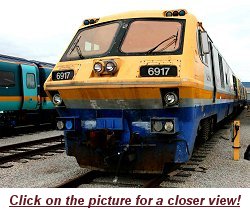 | |
The LRC (Light, Rapid, Comfortable) was built by Bombardier (MLW), Alcan and Dofasco in co-operation with CN and later VIA Rail Canada as a higher speed rail option for the busy Quebec City - Windsor Corridor. The locomotives were capable of travel up to 125 MPH (limited to 100 MPH in service) and powered VIA's Metropolis express train between Toronto and Montreal. These locomotives were a common sight throughout the Corridor from their introduction in 1981 until their retirement in 2001.
The LRC coaches are still the mainstay of VIA's fleet in the Corridor, and are currently being rebuilt for another 20 years of reliable service. The LRC perfectly straddles past and present. The engine was the last locomotive in North America built with an Alco 251 prime mover, and the LRC concept was the grandfather of Bombardier's high speed train program. Building upon ideas tested in the LRC, Bombardier has become one of the world leaders in high speed passenger rail equipment.
As the last of these locomotives were being scrapped, the TRHA mounted a fund raising campaign to acquire one of them from VIA. The campaign was a resounding success and the TRHA purchased #6917 from VIA in August of 2010. Plans are now being made to restore the unit to operating condition and eventually to move it to the museum site.
|
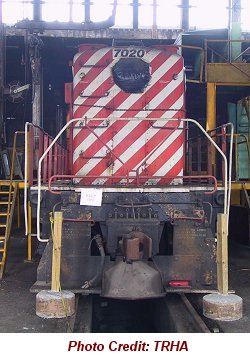
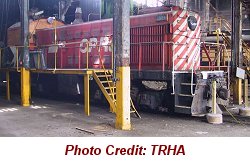
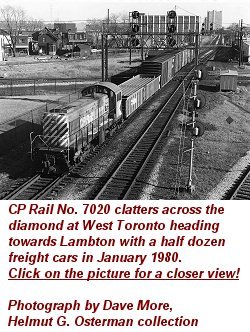 | |
A switcher type locomotive, CP Rail 7020 (class DS10-b, serial 72855) looks like she was "ridden hard and put away wet"!
The series 7010-7064 was constructed by the American Locomotive Company in partnership with General Electric at Schenectady, New York, in October, 1944. This was five years before Alco's Canadian affiliate, Montreal Locomotive Works (partnered with Canadian General Electric in Peterborough), built their first S-2 for Canadian Pacific. In the Alco-GE partnership, the locomotive builder constructed the mechanical portion of the unit's frame, cab, carbody, trucks or bogies - while the electrical systems , main generator, traction motors and control systems were provided by GE. This partnership continued from the 1930's into the middle 1950's, when General Electric began producing their own line of complete locomotives at their plant in Erie, Pennsylvania. Alco and MLW subsequently disappeared from the locomotive marketplace, leaving only General Motors and General Electric to the field.
The switcher has a specific function. That's why it's usually smaller, less powerful and slower than its mainline counterparts (like CNR 4803). Within a city or a railway yard, it is switchers which go to each industry and pull out freight cars as required until a complete train is made up. Then the road engines couple on for the long haul at higher sustained speeds (50 MPH and more) until they reach another yard. There another switcher takes over, breaking the train up into sections and delivering them locally as required.
7020 is a "war engine", acquired to meet the crushing demands of the World War II effort. In the late 1930's, diesel-electrics started to supplant steam locomotives in the switching function, primarily in urban areas. Steam switchers required two-person crews (an engineer and a fireman), had low availability (spending eight hours or more per day in servicing), and produced noxious, billowing clouds of coal or oil smoke unpopular with city dwellers. Even though diesel-electric switchers drew on the same limited sources of supplies used to construct tanks and warships, their overwhelming efficiency at a time of intense need led rationing authorities in Canada and the United States to permit their continued construction.
The S-2 was one of a family of Alco/MLW switchers produced from 1940 through the middle 1950's, when the motor and exterior changed. The S-2 was powered by a 539-type super charged six-cylinder inline four-cycle diesel producing 1000 horsepower. Weighing about120 tons, its electrical transmission permitted it a maximum safe speed of 60 MPH. Its trucks or bogies were designed by an engineer named Blunt, and are particularly agile when moving over rough inner-city industrial trackage or tight curvature.
The curvaceous exterior styling of the locomotive was a mild application of Art Deco principles by another Alco engineer, Ray Patten. CPR found the S-2 to be too large a locomotive for its needs and most later switcher purchases were of S-3's, a similar locomotive lighter in frame weight and producing 660 horsepower from an engine not equipped with a turbo supercharger.
CPR 7020 was assigned to Toronto from delivery (Parkdale Yard). It thus forms an integral part of the story of dieselization, of Canadian railways at war, and of Toronto's railway story.
The locomotive was donated by CP to the City of Toronto in 1986 for a museum on this spot.
It is our intention to restore it cosmetically and mechanically.
|
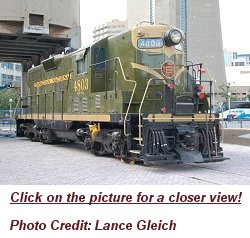
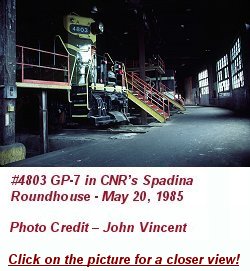
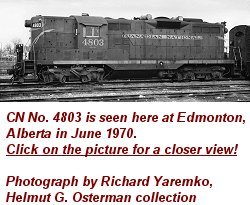 | |
This locomotive is the only item in the roundhouse which can be said to be of national significance to the history of Canadian railways. This diesel-electric road-switching locomotive appears to be mechanically complete and was previously restored to its pre-1960 paint scheme by the railway in 1984.
The rare high-nose GP7 was built by General Motors Diesel of London, Ontario, in August, 1953, as CN 7558. High-nose GP7's and GP9's - so called because their cab was located behind part of the hood, with limited forward visibility - were among the most significant of the diesel locomotive types which displaced steam power during the 1950's. Few exist in their original configuration at this time; most have had extensive mechanical and cosmetic alterations, and their "high noses" have been cut down to provide a truck-like windshield over the short hood. The original GP7 was built by General Motors in Chicago in 1949. By 1960, it had sired some 7,000 copies, many of which soldier on in secondary services today.
The road-switching locomotive concept was developed by the American Locomotive Company in 1941 with their RS-1 design. In essence, the road-switcher is a do-anything, go-anywhere locomotive, unlike the previous road locomotive designs which were streamlined and unidirectional. Devoid of decoration, the GP7 design is completely functional, bi-directional and eminently efficient. It was utilized in switching service, on heavy road freights and, where equipped with a steam heat boiler or electrical generator for hotel power, to pull passenger trains.
It is powered by a 16-cylinder two cycle diesel engine in an ìVeeî configuration. Each of the sixteen cylinders displaces 567 cubic inches, or about six times the entire displacement of the engine in a modern Toyota Corolla. This large, slow-turning engine produce 1500 horsepower to turn a 600 volt direct current generator; the generator provided current to four large electric motors mounted in the bogies, each driving one axle of the locomotive. The diesel engine also turned a large air compressor, which supply compressed air for the engine and train braking systems.
These locomotives were generally equipped with the capacity to run in sets of up to eight units under the control of single engineer. CN 4803 is also equipped with electrodynamic braking, evidenced by the bulge at the roofline on either side of the long hood. Electrodynamic braking is a process by which the electric motors are turned into generators and the current load produced by the momentum of the train is then dissipated as heat. This system supplemented the friction brakes normally used and greatly reduced wheel wear and wear on the brake shoes.
4803 is also mounted on specialized, lightweight flexicoil bogies or trucks; the truck frame casting is often one of the heaviest components in a diesel-electric locomotive, and 4803 was specially equipped to travel on lightly constructed western branch lines during the autumn grain rush every year. During most of the year, she ran in regular service throughout the country, but come fall, she would head to the prairies.
In 1984, 4803 was donated to the City by the railway in a public ceremony involving then-Mayor Art Eggleton. A brass plaque commemorating that event is held by CN's public affairs office on Front Street and will be returned to the City for installation on the locomotive when the museum is established. We are pursuing inquiries with the railway as to her final mechanical condition before retirement, in the hope that she can be made operational. Meanwhile, she is in superb cosmetic condition and requires little more than a careful washing to be an excellent display piece.
|
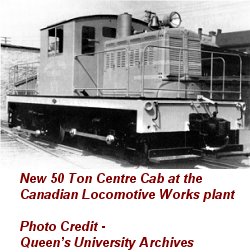
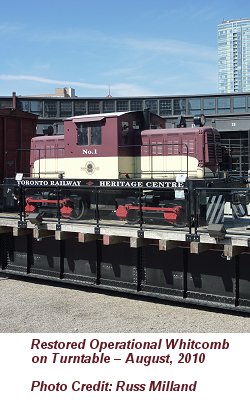 | |
The locomotive is a 50 Ton Diesel-Electric Whitcomb center-cab switcher and was manufactured by the Canadian Locomotive Company in 1950. The CLC was located in Kingston, Ontario and the switcher was No. 2637 of a total of 3064 steam and diesel locomotives built there between 1854 and 1968. The unit was manufactured under license from the Whitcomb Locomotive Company in the U.S., a subsidiary of the Baldwin Locomotive Company of Philadelphia, Pennsylvania.
The locomotive was sold to Limestone Products on February 6, 1952 for $43,000 plus tax. The Whitcomb was to be delivered within ten days from Kingston to the Limestone quarry in Scarborough, where it was used in industrial switching service for the next quarter century. In 1977, the engine was sold to Nelson Aggregates, an aggregate mining and construction materials supply company with various locations in southern Ontario.
Nelson Aggregates leased the diesel to the York-Durham Heritage Railway between 1994 and 1997, where it was used in work train service rebuilding the track between Stouffville and Uxbridge, Ontario. In 1997, the locomotive was leased to the Prince Edward County Railway Preservation Society and moved to Picton, Ontario, then moved to Trenton in 2000, where it remained until it was acquired by the Toronto Railway Museum in 2007.
The TRM needed a compact switching engine that was sufficiently powerful to move the largest locomotive in the collection, the giant Canadian National Railway steam locomotive No. 6213, currently stored at the Canadian National Exhibition Grounds and soon to be moved to the Roundhouse. The switcher's move to Toronto was contracted to Western Mechanical, the company that is currently restoring the John Street Roundhouse turntable bridge in Barrie, in anticipation of its reinstallation in the turntable pit in late 2007.
In addition to its utilitarian value in roundhouse switching service, the Toronto Railway Historical Association has determined that the locomotive constitutes a valuable heritage artifact in its own right.
The engine is typical of the thousands of locomotives manufactured for industrial switching purposes in North America and was used in several locations throughout southern Ontario, including Toronto.
The switcher is also a product of the Canadian Locomotive Company, the most important manufacturer of railway locomotives in Ontario throughout the first half of the 20th century.
Since this is the first locomotive specifically acquired for operation at the Toronto Railway Museum, it will receive the number 1.
The locomotive has been repainted in the attractive colours of the Toronto, Hamilton & Buffalo Railway, a "fallen flag" railway company whose engines regularly called at John Street throughout the Roundhouse's life as a passenger steam and diesel locomotive facility. The paint scheme will also compliment the TH&B caboose that that is part of the collection stored inside the Roundhouse. Since the engine was never actually associated with the TH&B, it will be decorated with the new logo of the Toronto Railway Museum.
|
|
 |





